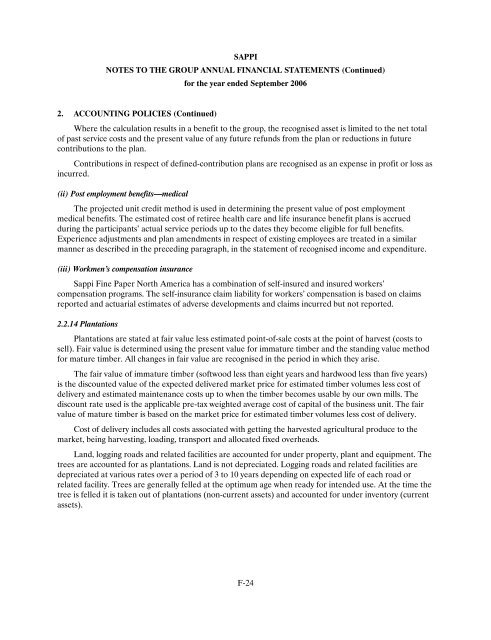You also want an ePaper? Increase the reach of your titles
YUMPU automatically turns print PDFs into web optimized ePapers that Google loves.
SAPPI<br />
NOTES TO THE GROUP ANNUAL FINANCIAL STATEMENTS (Continued)<br />
2. ACCOUNTING POLICIES (Continued)<br />
for the year ended September <strong><strong>20</strong>06</strong><br />
Where the calculation results in a benefit to the group, the recognised asset is limited to the net total<br />
of past service costs and the present value of any future refunds from the plan or reductions in future<br />
contributions to the plan.<br />
Contributions in respect of defined-contribution plans are recognised as an expense in profit or loss as<br />
incurred.<br />
(ii) Post employment benefits—medical<br />
The projected unit credit method is used in determining the present value of post employment<br />
medical benefits. The estimated cost of retiree health care and life insurance benefit plans is accrued<br />
during the participants’ actual service periods up to the dates they become eligible for full benefits.<br />
Experience adjustments and plan amendments in respect of existing employees are treated in a similar<br />
manner as described in the preceding paragraph, in the statement of recognised income and expenditure.<br />
(iii) Workmen’s compensation insurance<br />
<strong>Sappi</strong> Fine Paper North America has a combination of self-insured and insured workers’<br />
compensation programs. The self-insurance claim liability for workers’ compensation is based on claims<br />
reported and actuarial estimates of adverse developments and claims incurred but not reported.<br />
2.2.14 Plantations<br />
Plantations are stated at fair value less estimated point-of-sale costs at the point of harvest (costs to<br />
sell). Fair value is determined using the present value for immature timber and the standing value method<br />
for mature timber. All changes in fair value are recognised in the period in which they arise.<br />
The fair value of immature timber (softwood less than eight years and hardwood less than five years)<br />
is the discounted value of the expected delivered market price for estimated timber volumes less cost of<br />
delivery and estimated maintenance costs up to when the timber becomes usable by our own mills. The<br />
discount rate used is the applicable pre-tax weighted average cost of capital of the business unit. The fair<br />
value of mature timber is based on the market price for estimated timber volumes less cost of delivery.<br />
Cost of delivery includes all costs associated with getting the harvested agricultural produce to the<br />
market, being harvesting, loading, transport and allocated fixed overheads.<br />
Land, logging roads and related facilities are accounted for under property, plant and equipment. The<br />
trees are accounted for as plantations. Land is not depreciated. Logging roads and related facilities are<br />
depreciated at various rates over a period of 3 to 10 years depending on expected life of each road or<br />
related facility. Trees are generally felled at the optimum age when ready for intended use. At the time the<br />
tree is felled it is taken out of plantations (non-current assets) and accounted for under inventory (current<br />
assets).<br />
F-24
















